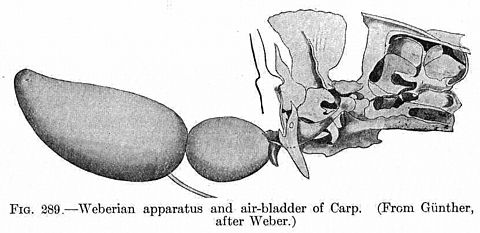
The Weberian apparatus is an anatomical structure that connects the swim bladder to the auditory system in fishes belonging to the superorder Ostariophysi. When it is fully developed in adult fish, the elements of the apparatus are sometimes collectively referred to as the Weberian ossicles or Weber's ossicles. The presence of the structure is one of the most important and phylogenetically significant distinguishing characteristics of the Ostariophysi. The structure itself consists of a set of minute bones that originate from the first few vertebrae to develop in an embryonic ostariophysan. These bones grow to physically connect the auditory system, specifically the inner ear, to the swim bladder.[1][2] The structure acts as an amplifier of sound waves that would otherwise be only slightly perceivable by the inner ear structure alone.
- ^ Rosen, Donn Eric; P. Humphry Greenwood (1970-08-26). "Origin of the Weberian Apparatus and the Relationships of the Ostariophysan and Gonorynchiform Fishes". American Museum Novitates (2428). New York, New York, USA: American Museum of Natural History.
- ^ Grande, Terry; Mario de Pinna (2004). G. Arratia & A. Tintori (ed.). The evolution of the Weberian apparatus: A phylogenetic perspective (PDF). Mesozoic Fishes 3 – Systematics, Paleoenvironments and Biodiversity. München, Germany: Verlag. pp. 429–448. ISBN 3-89937-053-8.